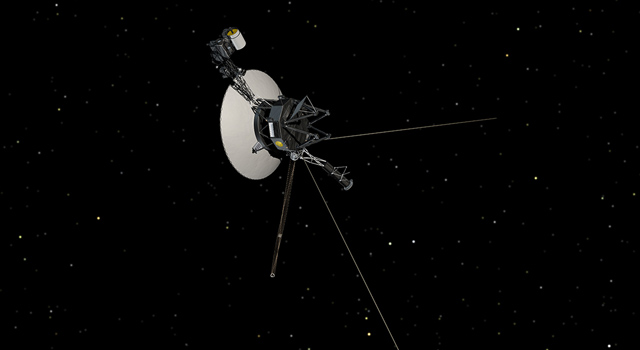News | February 12, 1990
Voyager 1 to Take Pictures of Solar System Planets

NASA's Voyager 1 spacecraft, having completed its mission along with Voyager 2 to explore the outer planets, will use its cameras February 13-14 to take an unprecedented family portrait of most of the planets in our solar system.
The collection of images will be from a unique point-of-view -- looking down on the solar system from a position 32 degrees above the ecliptic plane in which the planets orbit the Sun. No other spacecraft has ever been in a position to attempt a similar series of photos of most of the planets.
Voyager 1, launched in 1977, is now about 6 billion kilometers (3.7 billion miles) from Earth. The Voyager spacecraft are controlled by and their data received at the Jet Propulsion Laboratory, Pasadena, Calif.
"This is not just the first time, but perhaps the only time for decades that we'll be able to take a picture of the planets from outside the solar system," said Voyager Project Scientist Dr. Edward C. Stone of Caltech. No future space missions are planned that would fly a spacecraft so high above the ecliptic plane of the solar system, he said.
Starting shortly after 5 p.m. (PST) on Feb. 13 and continuing over the course of four hours, Voyager 1 will point its wide- and narrow-angle cameras at Neptune, Uranus, Saturn, Jupiter, Mars, Earth and Venus. Mercury is too close to the Sun to be photographed by Voyager's cameras, and Pluto is too far away and too small to show up in images taken by the spacecraft. Beginning with the dimmest of the targets - Neptune -- and working toward the Sun, Voyager 1 will shutter about 64 images of the planets and the space between them.
The constellation Eridanus (The River), stretching behind the planets from Voyager 1's perspective, will provide the backdrop for the images.
Due to the schedules of several spacecraft being tracked by NASA's Deep Space Network (DSN), the images will be recorded on board Voyager 1 and played back to DSN receivers on Earth in late March. The Voyager imaging team estimates that processing the images to reveal as much detail as possible will take several weeks. Most of the planets will appear as relatively small dots (about one to four pixels, or picture elements, in the 800-by-800 pixel frame of one Voyager image).
The enormous scale of the subject matter makes it unlikely that the entire set of images can be mosaicked to produce for publication a single photograph showing all the planets. Even an image covering the planets out to Jupiter would easily fill a poster-sized photographic print. At the least, imaging team hopes to assemble a mosaicked image composed of the frames showing Earth, Venus and perhaps Mars together.
Voyager 1, rather than Voyager 2, received the solar system photo assignment largely because of Voyager 1's improved viewpoint of the planets.
Voyager 1 completed flybys of Jupiter and Saturn in 1979 and 1980, respectively. Voyager 2 flew past Jupiter in 1979, Saturn in 1981, Uranus in 1986 and Neptune last August. Both are now on missions that will take the spacecraft to the boundary of our solar system and into interstellar space.
According to Voyager engineers and scientists, the only potential damage from pointing the cameras toward the Sun is that the shutter blades of the wide-angle camera might warp. There are no plans, however, to use Voyager 1's cameras after the solar system photo series is completed.
The Voyager mission is conducted by Caltech's JPL for NASA's Office of Space Science and Applications.
